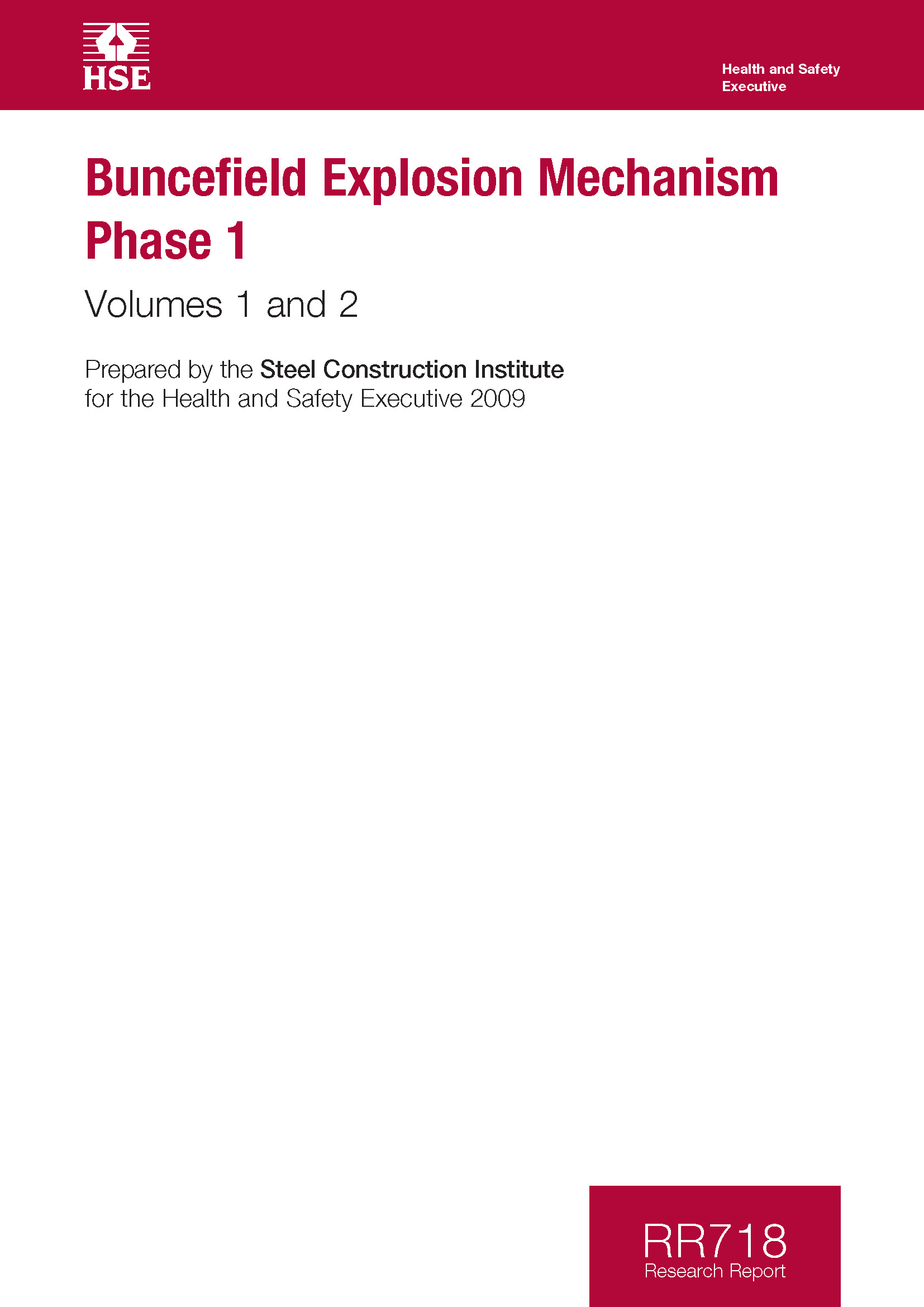HSE RR718
Buncefield Explosion Mechanism Phase 1
Volumes 1 and 2
BEM Phase 1

FABIG Members: Log-in to access all FABIG resources LOG IN
SUMMARY
The Buncefield explosion (11 December 2005) resulted in tremendous damage to the outlying area and huge fires involving 23 large oil fuel tanks. One important aspect of the incident was the severity of the explosion, which would not have been anticipated in any major hazard assessment of the oil storage depot before the incident. The Buncefield Major Incident Investigation Board (MIIB) invited explosion experts from academia and industry to form an Advisory Group to advise on the work that would be required to explain the severity of the Buncefield explosion. This MIIB Advisory Group carried out a preliminary assessment of the forensic evidence obtained following the incident and of the results of experiments carried out by the Health and Safety Laboratory (HSL). The objectives of this assessment were:
- To determine whether a sequence of events could be identified that would explain why such severe explosion pressures were generated; and
- if this was not possible, to recommend to the Board what further actions would be required to explain the explosion severity.
The Advisory Group attempted to explain the explosion event at Buncefield using deflagration, detonation or a combination of both. It also examined other possible means of flame acceleration. However, it was not possible to identify a single scenario that could explain all aspects within the time available. The Advisory Group therefore recommended that a joint industry research project be initiated that would, in its first phase, have the objectives of completing the assessment started by the Advisory Group and, on the basis of this, of defining the requirements for further research. The research undertaken, both experimental and theoretical, and has led to a better understanding of likely explosion mechanisms and explanation of the observed damage.
This report and the work it describes were jointly funded by the Health and Safety Executive (HSE), the UK Petroleum Industry Association (UKPIA), the Ministry of Housing of the Environment and Spatial Planning (The Netherlands), StatoilHydro and the Energy Institute. Its contents, including any opinions and/or conclusions expressed, are those of the authors alone and do not necessarily reflect HSE policy.
The full report is publicly available from the HSE Website at www.hse.gov.uk/research/rrhtm/rr718.htm.
TABLE OF CONTENTS
VOLUME 1
- ACKNOWLEDGEMENTS
- FOREWORD
- EXECUTIVE SUMMARY
- INTRODUCTION
- Background
- Objectives of this project
- Scope of project
- OBSERVATIONS AND OVERPRESSURE ASSESSMENT
- Witness statements
- CCTV records
- Damage to objects (other than buildings)
- Overall assessment of building damage
- Detailed assessment of building damage
- CHARACTERISATION OF THE BUNCEFIELD EXPLOSION
- Cloud characteristics
- Ignition location
- Timing of explosion phases
- Overpressure magnitude and distribution
- Explosion propagation
- How buncefield compares with previous incidents
- COMPARISON OF POTENTIAL SCENARIOS WITH THE BUNCEFIELD
- Explosion
- Deflagration scenario
- Detonation scenario
- Comparison of deflagration and detonation with the
- Evidence
- Alternative explosion mechanisms
- PROPOSALS FOR FURTHER WORK
- CONCLUSIONS
VOLUME 2
- APPENDIX A RELEVANT DATA COLLECTED FOLLOWING THE BUNCEFIELD ACCIDENT
- Introduction
- Cloud size
- Witness evidence
- Effect on witnesses
- CCTV records
- Camera shake on furnell yl camera
- Ignition location
- APPENDIX B REVIEW OF EVIDENCE ON OVERPRESSURES
- Introduction
- Overpressure estimates
- Small objects for pressure indicators
- Steel drums
- Boxes
- Oil filter
- Tyres
- Cars
- Overpressures outside the cloud - rapid decay with distance
- Overpressures in the emergency pump house
- Overpressures at a distance from buncefield
- Direction estimates
- Conclusions
- Abbreviation
- APPENDIX C POTENTIAL FOR HIGH SPEED DEFLAGRATION
- Introduction- gas cloud explosion mechanisms
- Detonation
- Computational fluid dynamics – the exsim model
- Exsim simulation of the buncefield incident
- Modelling the effects of more fine-scale congestion
- Large scale simulation using ethylene as an alternative to fine scale congestion
- Net impulse in open areas
- Expansion of gas cloud during explosion
- Consistency with damage observations
- Summary and conclusions
- References
- APPENDIX D POTENTIAL FOR DETONATION
- Introduction
- Mechanism
- Detonation scenario at buncefield
- Analysis of event timings
- Assessment of other aspects of the cctv records
- Modelling
- Pressure damage
- Lack of hearing damage in witnesses
- Summary of findings
- Conclusions
- References
- Annexe 1 – kingston cfd modelling
- APPENDIX E POTENTIAL FOR ALTERNATIVE EXPLOSION MECHANISMS
- Introduction
- Description of candidate mechanisms
- Factors potentially affecting combustion rate
- Conclusions
- References
- APPENDIX F ASSESSMENT OF STRUCTURAL DAMAGE
- Background
- Introduction
- References
- APPENDIX G REVIEW OF PREVIOUS SIMILAR ACCIDENTS
- Introduction
- Data quality
- Release and cloud variables
- Explosion character
- Correlations between release variables and explosion type
- Conclusions
- Incident data
- References
- APPENDIX H MODELLING OF PANCAKE CLOUD DETONATIONS
- Introduction
- Simulations
- Discussion
Online purchase options:
Non-Members of FABIG are able to purchase PDF copies of the reports.